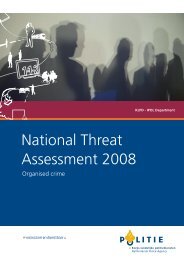Assessing the Effectiveness of Organized Crime Control Strategies ...
Assessing the Effectiveness of Organized Crime Control Strategies ...
Assessing the Effectiveness of Organized Crime Control Strategies ...
You also want an ePaper? Increase the reach of your titles
YUMPU automatically turns print PDFs into web optimized ePapers that Google loves.
Ano<strong>the</strong>r audit by <strong>the</strong> US General Accounting Office (1994) documents <strong>the</strong> limitations <strong>of</strong> <strong>the</strong><br />
reporting requirement for <strong>the</strong> movement <strong>of</strong> over $10,000 in currency into or out <strong>of</strong> <strong>the</strong> US. Just a<br />
fraction <strong>of</strong> currency being smuggled across <strong>the</strong> American border is seized. The audit concluded<br />
that <strong>the</strong> volume <strong>of</strong> smuggled currency cannot be ascertained due to <strong>the</strong> clandestine nature <strong>of</strong> <strong>the</strong><br />
activity. The smuggling <strong>of</strong> cash is impeding efforts to control money laundering.<br />
The evidence from <strong>the</strong> United Kingdom does not invite greater optimism. As <strong>of</strong> 1995, 16,000<br />
suspicious transaction reports had been filed—60-fold <strong>the</strong> number initially predicted (Levi,<br />
1997:7). Fewer than one-half <strong>of</strong> one percent <strong>of</strong> <strong>the</strong>se reports have been found to lead to new<br />
investigations or have had a significant impact on <strong>the</strong> outcome <strong>of</strong> a case (Levi, 1997:8). Levi<br />
(1997:7) notes that <strong>the</strong>se reports, “seldom provide information that would enable <strong>the</strong> police or<br />
customs to mount a surveillance operation on a target <strong>of</strong>fender. The information does help to<br />
build up a pr<strong>of</strong>ile, and multiple reports on <strong>the</strong> same person or on connected persons may trigger<br />
more detailed investigation, but mainly if <strong>the</strong> person is “already” known or under investigation<br />
anyway.” Levi adds that because just a small proportion <strong>of</strong> reports receive more than routine<br />
checks on criminal intelligence databases, <strong>the</strong> proportion <strong>of</strong> reports that would yield evidence <strong>of</strong><br />
crime, if followed up thoroughly, is unknown.<br />
Gold and Levi (1994:87) express doubts about <strong>the</strong> potential <strong>of</strong> suspicion-based disclosure<br />
systems to detect major crime because <strong>the</strong> evidence indicates that large-scale <strong>of</strong>fenders tend to be<br />
aware that large deposits in legitimate financial institutions will create problems for <strong>the</strong>m. Gold<br />
and Levi point out that such <strong>of</strong>fenders adapt to <strong>the</strong>se reporting requirements and this accounts for<br />
an increase in <strong>the</strong> use <strong>of</strong> exchange bureaus and for <strong>the</strong> use <strong>of</strong> financial systems in European<br />
countries with less stringent reporting rules. They add that <strong>the</strong>re is little evidence that financial<br />
institutions have been successful in spotting <strong>the</strong> misuse <strong>of</strong> front companies that intermingle<br />
crime-related with legitimate proceeds. In general, <strong>the</strong> surveillance <strong>of</strong> business accounts by bank<br />
staff tends to be minimal. Most transactions classified as suspicious are unsophisticated and<br />
involve personal accounts <strong>of</strong> known individuals.<br />
In 1988, Australia established one <strong>of</strong> <strong>the</strong> most advanced reporting systems via its Cash<br />
Transaction Reporting Agency (now referred to as AUSTRAC). By 1993, approximately 90<br />
percent <strong>of</strong> cash transactions over A$10,000 were electronically conveyed to AUSTRAC (Levi,<br />
1997:8). In addition to <strong>the</strong> reporting <strong>of</strong> significant transactions, this system has a suspicious<br />
transaction reporting component. Between 1990 and 1993, 1.6 million significant transactions<br />
were reported. In 1994-95, AUSTRAC received 36,000 reports <strong>of</strong> international currency<br />
transfers, close to one million reports <strong>of</strong> cash transactions, and 3.6 million reports <strong>of</strong><br />
international capital transfers. The estimated cost <strong>of</strong> supplying <strong>the</strong>se reports in 1992 was A$3.5<br />
million. According to Levi (1997), <strong>the</strong> Australian Tax Office made modest claims regarding <strong>the</strong><br />
value <strong>of</strong> <strong>the</strong> significant transaction reports, because <strong>the</strong>ir efforts were focused on transactions<br />
deemed to be suspicious. Law enforcement authorities, too, have made few claims about <strong>the</strong><br />
impact <strong>of</strong> significant transaction reports. The Australian Senate Standing Committee on Legal<br />
and Constitutional Affairs called for <strong>the</strong> retention <strong>of</strong> significant transaction reports partly on <strong>the</strong><br />
basis <strong>of</strong> <strong>the</strong> view that it was too early to comment on <strong>the</strong>ir forensic value (Levi, 1997:9).<br />
Between 1990 and 1995, just over 20,000 suspicion-based reports were forwarded to<br />
AUSTRAC. The additional revenue generated by AUSTRAC averages $13 million per year,<br />
Research and Statistics Division / Department <strong>of</strong> Justice Canada | 25








